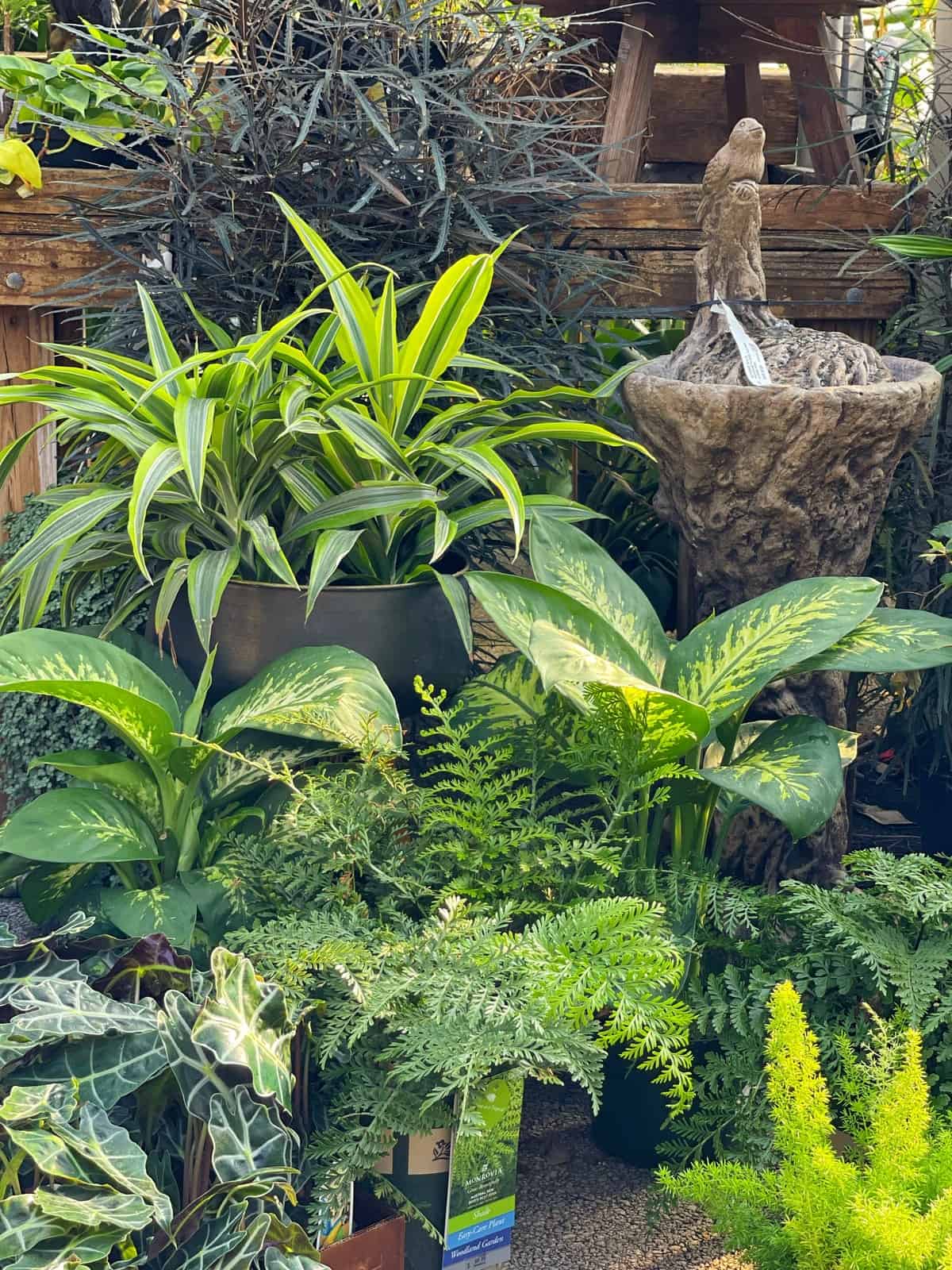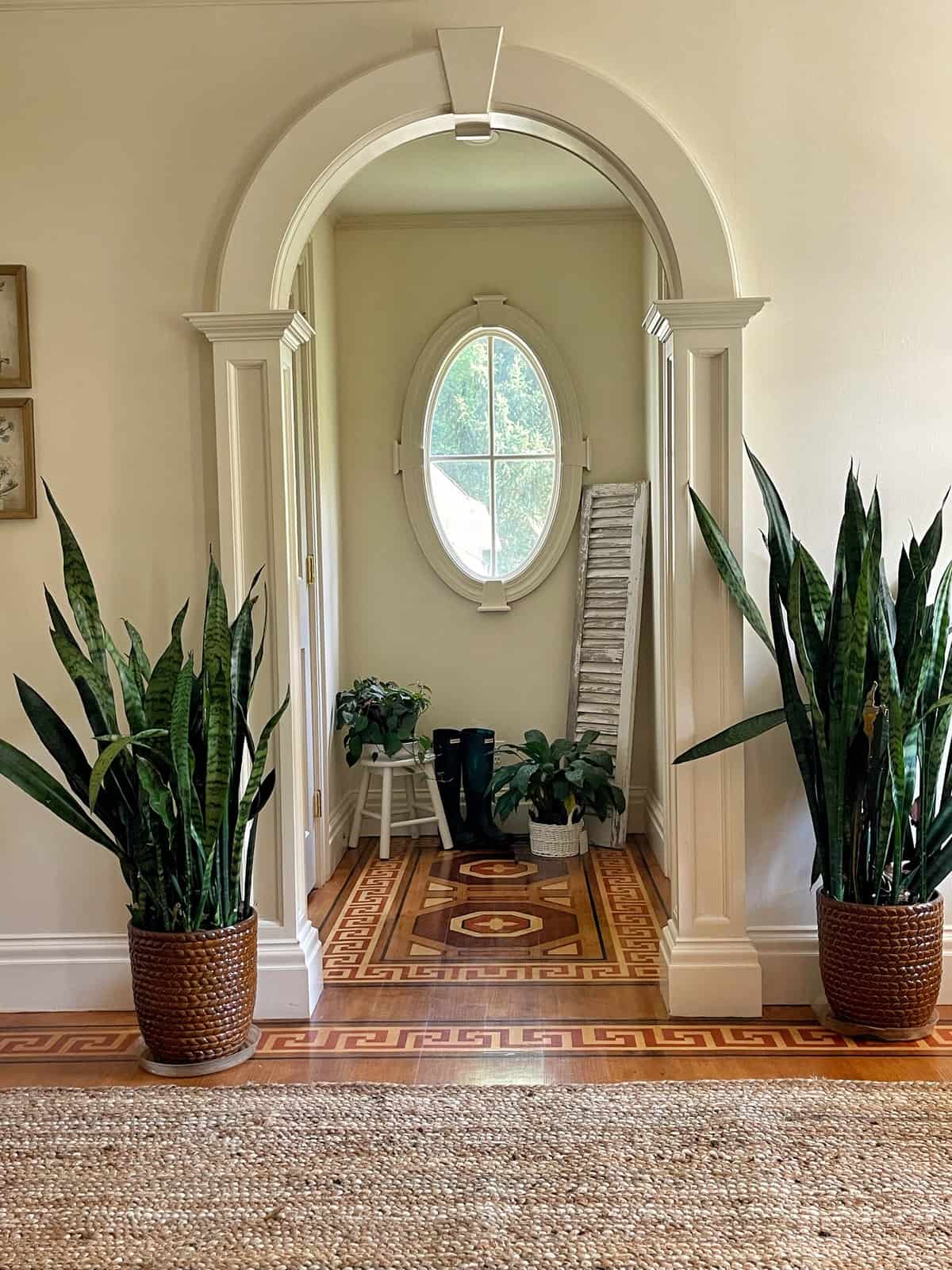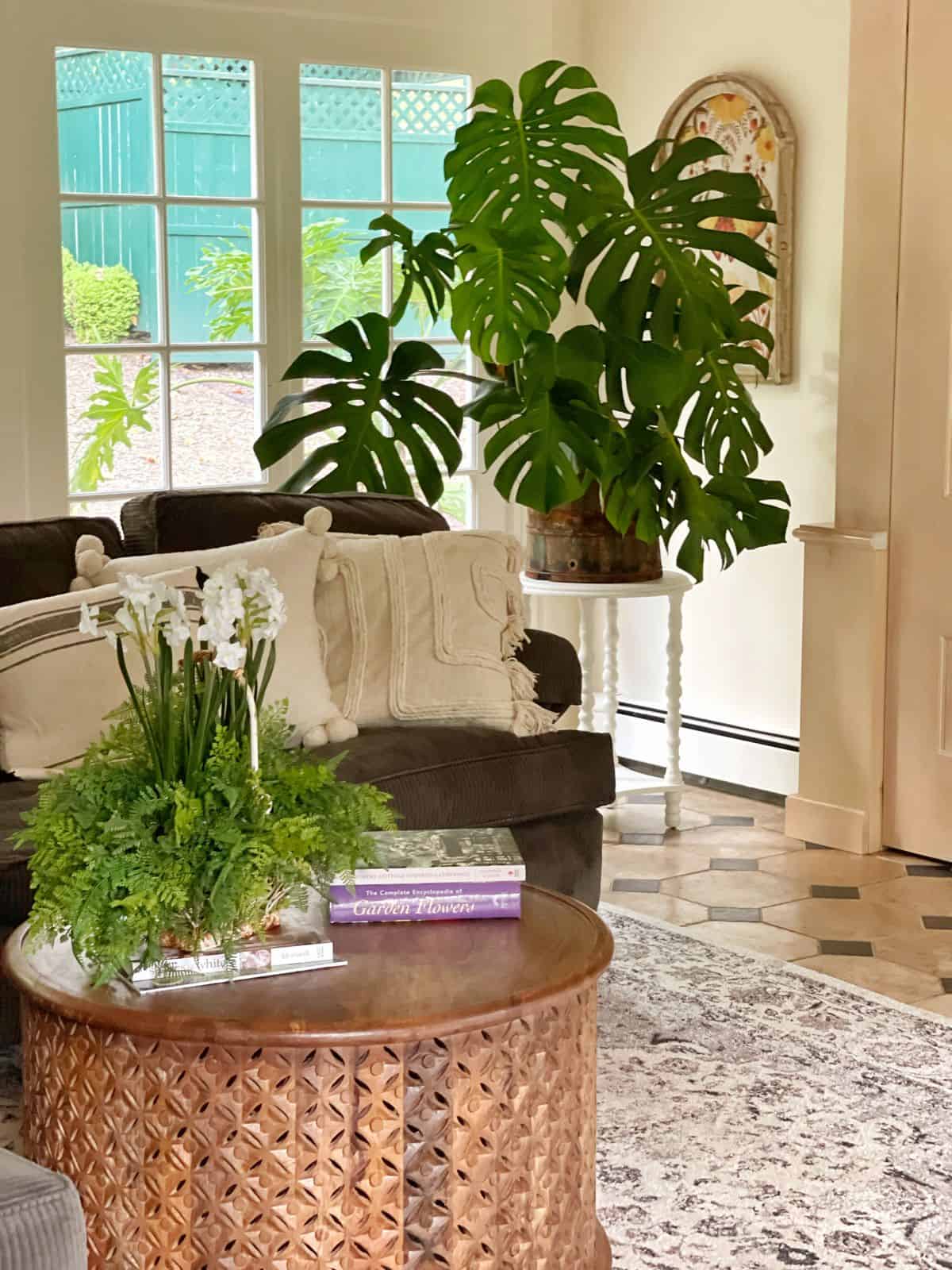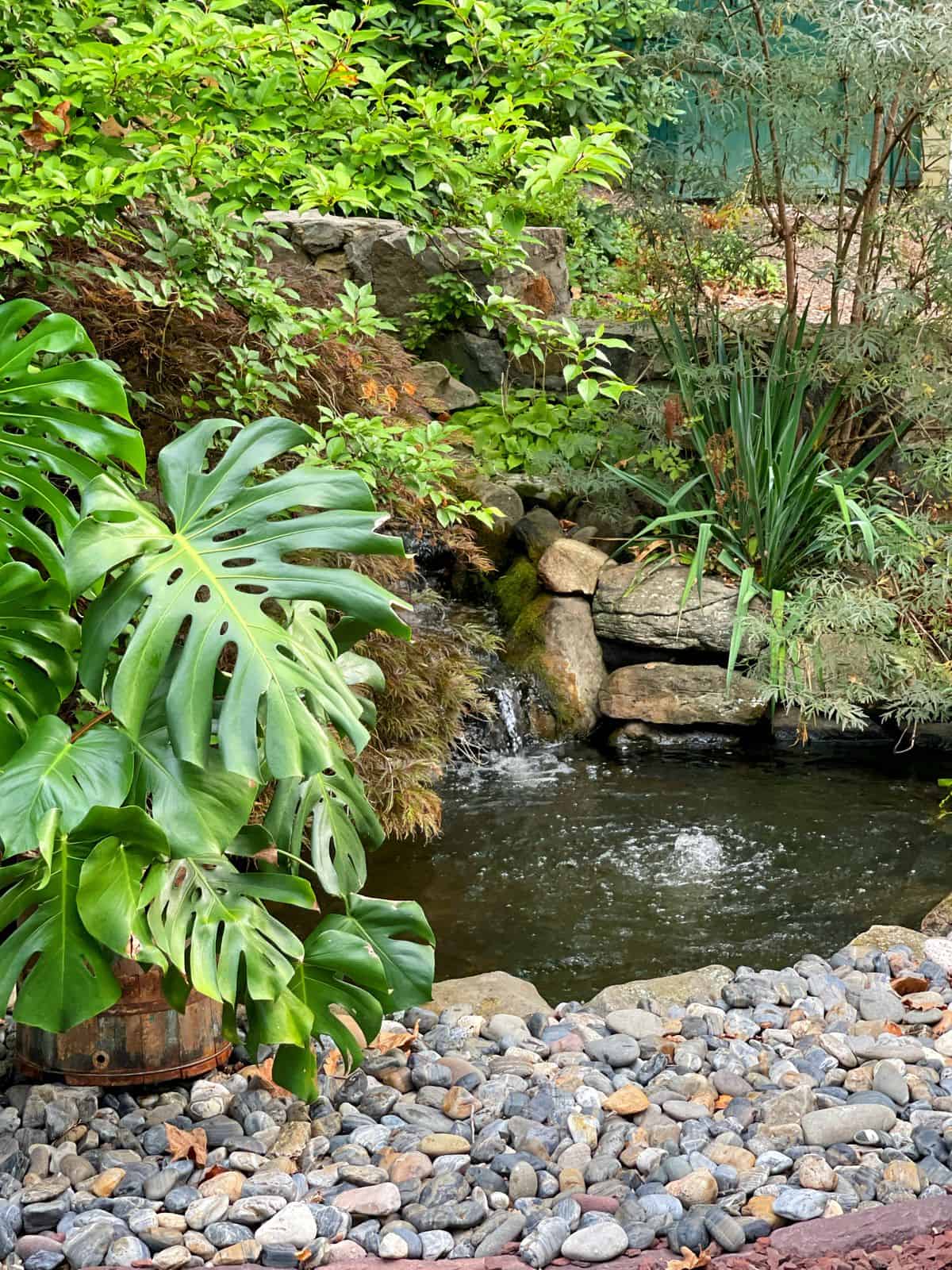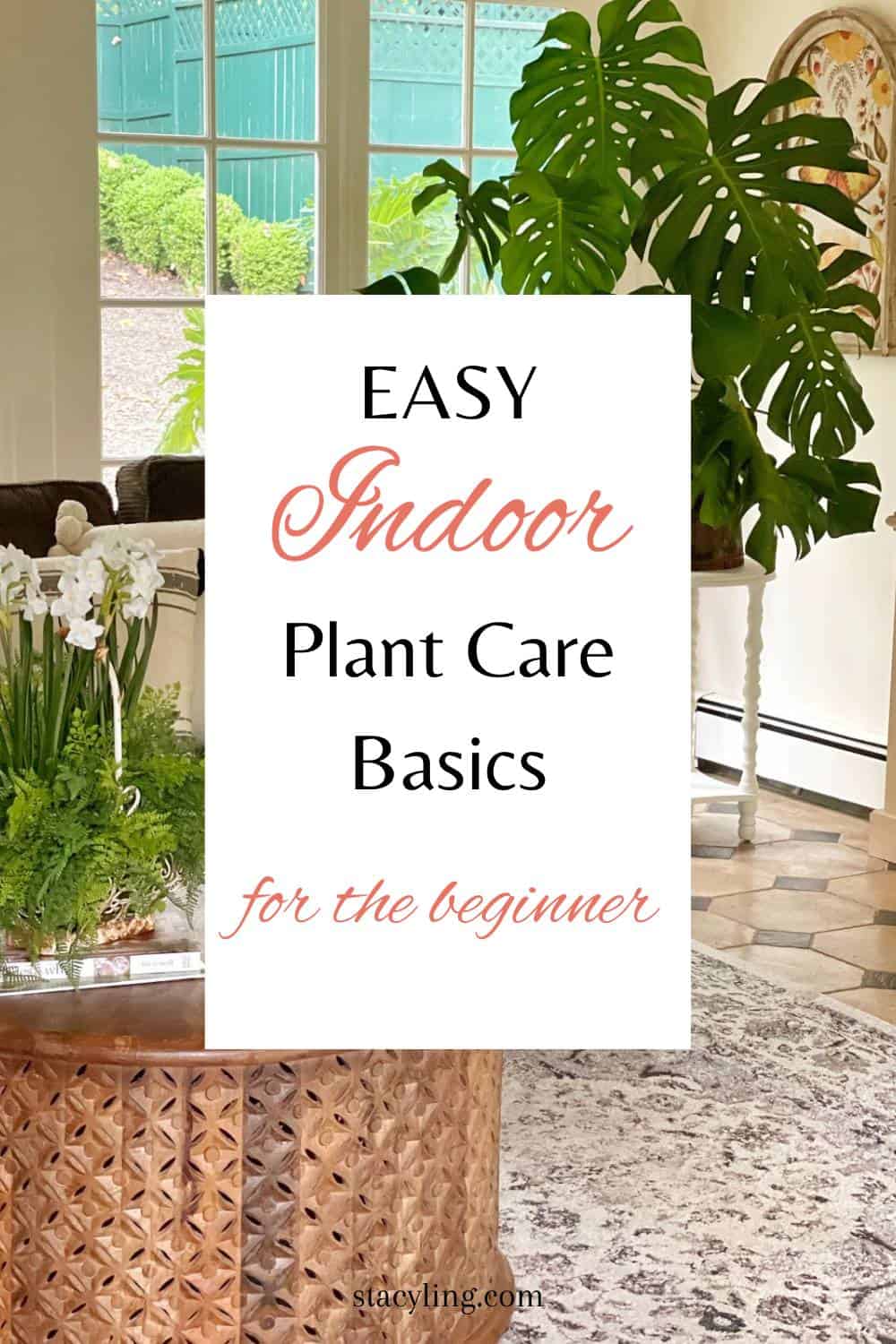Your stress-free guide to easy houseplants! Perfect for busy individuals and newbies. Grow a thriving indoor garden with these simple, low-maintenance tips.
Ever dream of an indoor jungle but think your thumbs are more “black hole of plant death” than “green goddess”? Forget those finicky ferns and temperamental orchids. There’s a whole secret squad of houseplants out there just itching to make your home their lush, low-maintenance oasis.
No daily misting, no sunlight symphonies – just occasional waterings and the occasional “wow, you’re still alive!” high five. Dive in, because these easy-going houseplants willbring a touch of the tropics (without the humidity tantrums) to your life, regardless of your schedule or horticultural history.
Get ready to unlock your inner plant parent – the stress-free kind! If you are a novice to growing houseplants or think you have a not-so-green thumb, then this post is for you!
From easy care houseplants you can’t kill to general indoor plant care tips, this post will help you become the plant parent you’ve always wanted to be.
(Posts on stacyling.com may contain affiliate links. Click HERE for full disclosure.)

Why Even the Busiest of People Should Grow Houseplants
Feeling a little overwhelmed with the thought of growing indoor plants on top of everything else you are doing? Even the busiest schedules can make room for the calming presence of houseplants.
Imagine coming home to a lush, green space that instantly reduces stress and boosts your mood. That’s the power of indoor plants, and it’s easier than you think. They purify the air, beautify living spaces, and help us feel happier, more productive, and less stressed.
Like many, I used to struggle with houseplants, but I learned that with the right knowledge, anyone can succeed. As my knowledge and experience grew, there were a few steps I took that have dramatically improved the overall health of my houseplants. A little knowledge can go a long way, so let’s get started learning how you can achieve this too.

Easy Houseplants for Beginners and Busy People
Whether you’re new to houseplants, juggling a busy schedule, or have faced plant-care challenges, this guide provides the essential basics to cultivate your inner ‘plant parent.’ The secret? Matching plants to your lifestyle and home environment. Not all plants are created equal, and even the most experienced gardeners experience setbacks. So, embrace the learning process, and let’s explore how to choose the right plants for your success.
For those of us with limited time, starting with easy-care, resilient plants is key to building confidence. By selecting low-maintenance options that thrive in various conditions, you’ll enjoy the beauty of greenery without the stress. To help you begin your journey, here’s a curated list of low-maintenance houseplants that are perfect for busy lifestyles:
Easy Houseplants that are Hard to Kill
- Pothos: This cascading cutie trails with heart-shaped leaves, tolerates low light, and needs infrequent watering.
- Snake Plant: These upright, sword-like wonders require minimal water and can handle bright or indirect light. They’re practically unkillable, making them perfect for plant parent apprentices.
- Anthurium Lily: Flaunting vibrant blooms and glossy foliage, this tropical stunner prefers medium-light and moist soil. Its air-purifying powers are a bonus!
- Peace Lily: This elegant beauty boasts white flowers and a forgiving nature. It tells you when it’s thirsty by drooping its leaves, so even forgetful folks can keep it happy.
- Philodendron: With endless varieties and climbing or cascading options, philodendrons add a touch of the tropics to any space. They’re adaptable to light and watering, making them ideal for laid-back plant parents.
- Cacti and Succulents: These desert dwellers store water in their plump leaves, so infrequent watering is their love language. Plus, their diverse shapes and textures add instant visual interest.
- Christmas (Holiday) Cactus: Unlike its name suggests, this festive fella blooms in late winter or early spring. It thrives in bright, indirect light and enjoys dry soil between waterings. Talk about a low-key holiday celebration!
- Spider Plant: Not just for hanging baskets, spider plants produce adorable spiderettes (baby plants!) you can propagate and share. They tolerate low light and infrequent watering, making them ideal for busy plant parents.
- Aloe Vera: This medicinal marvel not only soothes sunburns but also thrives on neglect. Water it when the soil is dry, and enjoy its air-purifying properties and sculptural good looks.
- Monstera Plant: This statement piece boasts glossy, split leaves and loves medium to bright indirect light. Water it when the top inch of soil dries, and watch your mini-jungle take shape.
- ZZ plant: This architectural gem flaunts glossy, emerald leaves and thrives in low light. Water it sparingly, and witness its slow, steady growth – perfect for patient plant parents.

Start Here: The King of Easy Houseplants to Grow
Sansevierias (snake plants) are the EASIEST houseplants to grow and care for. If you are new to growing indoor plants or are busy, start with one of these. They are easy to find, easy to grow, and extremely hardy. They can handle a variety of growing conditions, thrive on neglect, and require minimal watering and can tolerate low light.
To give you an example, I moved one to our Vermont cabin, and we sometimes aren’t there for a few months. There are some occasions that I notice the foliage looking like it needs water. But they are so resilient that once given that water, they bounce right back. So if you want to try your hand with houseplants, I suggest starting with a snake plant.

Light: Understanding Your Home’s Light
Knowing and understanding your home’s light conditions and where you want to grow indoor plants should all be considered before bringing one home from the nursery. In general, houseplants fall under one of three light condition categories:
- high
- medium
- low
Once you have a general understanding of what each means and how they translate in your home, you will be on the road to plant parenting success.

How to Determine Your Light Conditions
Different areas of your home will offer different types of light. So try to figure out which light conditions you have where. You can do this by determining where north, south, east, and west is in your home. If you aren’t sure, grab your cell phone compass to help you figure it out. Think about where the windows are in each room and what light exposure it provides so you know the types of plants that can grow in that environment.
Types of Light
When you buy houseplants, read the plant tags and choose ones that match the light conditions you can offer.
- High Light: southern or southwestern exposure window.
- Medium Light: east or west window with direct exposure or bright indirect light from filtered spots near a southern exposure window.
- Low Light: north windows or indirect light that is several feet from east, west, or south-facing windows.

The Importance of Plant Tags
The biggest mistake new indoor gardeners make is to site indoor plants where they think they will look good, but not necessarily where the plant needs to grow in order to survive. So it’s really important to know the light conditions you have and read that plant tag in order to achieve success growing houseplants. Those plant tags are your friend because they tell you how to grow that particular plant.
Before you put an indoor plant on your car, ask yourself if that plant’s light requirements are a match for the location you want to place it in your home. If it’s not, put it back on the cart because you won’t enjoy growing it.
After you bring your plants home, keep an eye on them for signs of distress because they will let you know when they are not happy with given light conditions. Distressed houseplants may show leaf drop, yellow foliage, or spindly stems. When a plant receives too much light, it can cause pale foliage or leaf burn.
But houseplants sometimes show some distress after the initial move from a greenhouse to your home, and that is normal. However, if a plant does not bounce back or gets worse, consider the light conditions it is receiving.
Indoor Plant Growing Tip: It’s a good idea to turn your plants every now and again so they grow evenly. Oftentimes, we leave them where we first place them and plants will stretch in one direction to reach the light causing them to look lopsided. Turning plants every now and again will help maintain an optimal shape.

Bringing Light Indoors: The Magic of Grow Lights
Sometimes, our dream plant placement doesn’t align with natural light conditions. Perhaps you envision a lush fern in a dimly lit corner. Where there’s a will there’s a way! Grow lights offer a fantastic solution, allowing you to cultivate plants virtually anywhere in your home.
Modern grow lights have come a long way. They are energy-efficient, available in various spectrums to mimic natural sunlight, and come in stylish designs that blend seamlessly with home décor. By supplementing natural light with grow lights, you can provide your plants with the necessary energy for photosynthesis, even in spaces that would otherwise be unsuitable.
Whether it’s a dedicated shelf with grow lights for a mini indoor garden or a single spotlight like this highlighting a prized plant, grow lights empower you to create your green oasis regardless of your home’s natural light limitations. They are the key to unlocking the full potential of your indoor plant collection, allowing you to truly grow anything, anywhere.

Choosing the Right Soil: The Foundation for Healthy Houseplants
The right soil is critical for successful houseplant care. While light and water get much of the attention, a plant’s roots live and breathe in the soil, making it a critical factor in their health. Not all soils are created equal, and understanding your plant’s specific needs is essential.
Easy Houseplants and The Importance of Well-Draining Soil
One universal rule for most houseplants is to avoid soil that retains too much moisture. Soggy soil leads to root rot, a common killer of indoor plants. Well-draining soil allows excess water to flow through, providing the roots with the oxygen they need.
Different Plants, Different Soil Needs
- Tropical Plants: Many common houseplants, like pothos, philodendrons, and monsteras, prefer a well-draining, airy mix. Look for a potting mix labeled “tropical” or “indoor potting mix.”
- Succulents and Cacti: These desert dwellers need a fast-draining, gritty mix. Look for a “cactus/succulent mix” or create your own.
- Orchids: These epiphytes (plants that grow on other plants) require a very chunky mix, often made of bark, perlite, and sphagnum moss.

Easy Houseplants: Creating a Chunky, Well-Draining Mix
For many plants, a chunky mix that provides excellent drainage and aeration is ideal. You can create your own or purchase pre-made mixes.
DIY Chunky Mix
- Combine standard potting mix with perlite and orchid bark. A ratio of 1:1:1 is a good starting point.
- Perlite adds aeration and drainage.
- Orchid bark provides larger chunks that create air pockets.
- Coco coir or pumice are also excellent additions.
Pre-made Mixes
- Many brands offer pre-made chunky mixes like this one specifically designed for aroids (plants in the Araceae family, like monsteras and philodendrons). These often contain the ingredients mentioned above and are convenient options.
- Cactus and Succulent mixes are also readily available.

Why a Chunky Mix?
A chunky mix prevents soil compaction, which can suffocate roots. It also allows water to drain quickly, reducing the risk of root rot. The larger particles create air pockets that promote healthy root development.
Tips for Soil Success
- Make sure that the pot you use has drainage holes.
- Always use fresh potting mix when repotting.
- Avoid using garden soil for indoor plants, as it can contain pests and diseases.
- Consider using terracotta pots, which help with drainage.

Creating the Right Environment For Easy Houseplants: Temperature and Humidity
Beyond light, water, and soil, temperature and humidity play vital roles in the health of your houseplants. While most common houseplants are adaptable, understanding their preferences can significantly improve their well-being.
Temperature
- Most indoor plants thrive in average room temperatures, between 65°F and 80°F (18°C and 27°C).
- Avoid placing plants near drafts from heating or cooling vents, as sudden temperature fluctuations can stress them.
- Be mindful that some plants, like succulents and cacti, may prefer slightly cooler temperatures during their dormant period in winter.
Humidity
- Many tropical houseplants prefer higher humidity levels than those typically found in homes, especially during dry winter months.
- Signs of low humidity include brown leaf tips and edges.
- Increase humidity by:
- Grouping plants together.
- Using a humidifier.
- Placing plants on a pebble tray filled with water.
- Misting plants regularly (though this is less effective long-term).
- Succulents and cacti generally prefer lower humidity.
Quick Tips
- Adjust your care routine as needed to create a more suitable environment.
- Research the specific temperature and humidity preferences of your plants.
- Observe your plants for signs of stress related to temperature or humidity, such as wilting or brown leaf tips.

Watering Easy Houseplants: The Key to Healthy Roots
The most common houseplant mistake? Overwatering. It’s crucial to prevent your plants from sitting in soggy soil, as this is the primary reason indoor plants fail. Often, when a plant declines, we assume it needs more water, leading to further problems.
However, the plant may actually be “drowning,” as soggy roots create an environment for pests and diseases. Many beginners water based on the surface dryness of the soil or follow a rigid weekly schedule, both of which are ineffective methods.
Here’s why: Container soil acts like a sponge. When a soaked sponge is held upright, water accumulates at the bottom, while the top appears dry. Similarly, the surface of your soil may feel dry, but the roots below could be sitting in excess moisture.
So, how do you determine when to water? Check the soil deeper where the roots are located. You can do this by inserting your finger about an inch into the soil. But it can also be done a moisture meter like this.

How I Water My Indoor Plants
Depending on the time of year, I generally water my plants about once a week, but I always check the soil moisture first. If the soil is moist 1-2 inches down, I wait and check again in a few days. I also perform a monthly flush by soaking the pots in the sink or tub and allowing them to drain thoroughly. During winter, I significantly reduce watering. For succulents and cacti, I water sparingly, about once a month or less, especially during the winter months.
Indoor Plant Care Tip: When you bring home new plants, use the ‘cake batter test’ for the first few weeks to gauge their watering needs. The cake batter test is when you check the moisture of the soil, and it should have the consistancy of cake batter. Not too wet, and not too dry

Fertilizing Indoor Plants For Year Round Growth
To truly thrive, houseplants need consistent nourishment. While traditional advice often suggests limiting fertilizer during winter dormancy, I’ve found that a gentle, year-round feeding approach yields remarkable results. By using a diluted, organic fertilizer every time I water, my plants maintain steady growth and avoid the ‘struggle bus’ that often hits during a long, dark winter.
This method mimics the natural, continuous nutrient supply plants receive in their native environments. It’s particularly beneficial for indoor plants, which often lack the diverse soil ecosystem of outdoor gardens. Using a gentle, organic fertilizer minimizes the risk of overfeeding, even with frequent applications.
Here’s how I do it: I use a liquid, organic fertilizer like this one that is specifically formulated for indoor plants, and dilute it to about one-quarter of the recommended strength. This gentle solution is applied every time I water, ensuring a consistent supply of nutrients without overwhelming the plants.
This approach has transformed my indoor garden. My plants are vibrant, healthy, and consistently growing, even during the winter months. Instead of waiting for a spring ‘wake-up,’ they maintain a steady, robust health throughout the year.
Indoor Plant Care Tip: Always use a diluted fertilizer to prevent nutrient burn. Experiment with the dilution to find what works best for your plants, and be sure to observe your plants closely for any signs of over or under-fertilization.

Protecting Your Easy Houseplants: Identifying and Controlling Pests & Diseases
Maintaining healthy houseplants involves more than just watering and light; it also requires vigilance against pests and diseases. Regular inspection is key, both when you first bring a plant home and throughout its life. Early detection allows for easier treatment and prevents widespread issues.
Identifying Common Pests
- Spider Mites: Look for fine webbing, tiny moving dots (they can be red, black or brown), and yellowing leaves.
- Aphids: These small, pear-shaped insects come in various colors (green, black, white) and cluster on new growth. They leave behind a sticky substance called honeydew.
- Mealybugs: Cottony, white masses indicate mealybugs. They often hide in leaf crevices and stems.
- Fungus Gnats: These small, dark flies hover around the soil surface. Their larvae can damage roots.
- Scale Insects: These appear as small, brown, immobile bumps on stems and leaves.
Recognizing Common Diseases
- Root Rot: Yellowing leaves, wilting, and a foul odor from the soil indicate root rot, usually caused by overwatering.
- Powdery Mildew: A white, powdery substance on leaves signals powdery mildew, often due to poor air circulation.
- Leaf Spot: Brown or black spots on leaves can be caused by fungal or bacterial infections.

Treatment Strategies
For Pests
- Isolate the affected plant to prevent spread.
- Wipe down leaves with a damp cloth or cotton ball dipped in rubbing alcohol.
- Use insecticidal soap or neem oil, following product instructions carefully.
For Diseases
- Remove affected leaves or stems to prevent spread.
- Improve air circulation around the plant.
- Repot the plant with fresh, well-draining soil if root rot is suspected.
- Use a fungicide, if necessary.
Prevention
- Use well-draining potting mix.
- Avoid overwatering.
- Provide adequate air circulation.
- Regularly inspect plants for signs of trouble.
The Importance of Plant Identification
Accurate plant identification is crucial for effective pest and disease control. Plant tags are your first line of defense; keep them or take photos. If you’re unsure, online plant identification tools or your local gardening extension can help. By being proactive and informed, you can keep your houseplants healthy and thriving.

Repotting Houseplants: Giving Roots Room to Grow
While it’s tempting to keep houseplants in their original nursery pots, these containers often become too small as plants grow, leading to a condition called ‘root-bound.’ Root-bound plants have tangled roots that restrict growth and can cause decline due to insufficient space and nutrients. Repotting provides fresh soil and room for roots to expand, promoting healthier and more vigorous growth.
Recognizing the Signs of a Root-Bound Plant
- Roots Emerging from Drainage Holes: If you see roots growing out of the pot’s drainage holes, it’s a clear sign your plant needs a larger home.
- Roots Circling the Inside of the Pot: Gently remove the plant from its pot. If the roots form a dense, circular mat around the inside, repotting is necessary.
- Water Drains Quickly: When water runs straight through the pot without being absorbed, it indicates the roots have taken up most of the soil.
- Slowed Growth: If your plant’s growth has significantly slowed or stopped, and other care factors are adequate, root-boundness could be the culprit.
- Wilting Despite Watering: A root-bound plant may struggle to absorb water, leading to wilting even after watering.

How to Repot Your Houseplant
- Choose the Right Pot: Select a pot that is one size larger in diameter than the current pot. Avoid going too large, as this can lead to overwatering issues.
- Prepare the Pot: Ensure the new pot has drainage holes. You can add a layer of well-draining potting mix to the bottom of the pot.
- Remove the Plant: Gently loosen the plant from its current pot. If the roots are tightly bound, carefully loosen them with your fingers.
- Position the Plant: Place the plant in the center of the new pot, ensuring the top of the root ball is level with the pot’s rim.
- Add Potting Mix: Fill the remaining space around the plant with fresh, well-draining potting mix. Gently firm the soil around the plant.
- Water Thoroughly: Water the plant thoroughly to settle the soil and help the roots establish.
Easy Houseplants: After Repotting Care
- Avoid fertilizing for a few weeks to allow the plant to adjust.
- Monitor the plant for signs of stress, such as wilting or leaf drop.
- Provide appropriate light and watering as needed.

Easy Houseplants on Summer Vacation
Just like us, houseplants thrive with a summer getaway! Most tropical indoor plants flourish in warm, humid conditions. When temperatures consistently rise and the threat of frost has passed, consider moving your houseplants outdoors. However, avoid exposing them to direct midday sun, which can scorch their leaves.
In my zone 6b climate, I move my plants outdoors around mid-May and bring them back inside before night time temperatures dip below 50 degrees. This outdoor exposure significantly boosts their growth; my plants often double or triple in size and become much healthier year-round. When moving them outside, I give them a dose of slow-release fertilizer.
During the hottest summer months (late June to August), when temperatures exceed 80°F (27°C) and humidity is high, I water them almost daily, similar to my outdoor container plants. An added perk? Your deck or patio will transform into a tropical oasis. Even in New Jersey, you can create that vacation vibe! I keep my plants under a covered porch or awning, providing them with shade from intense sunlight.

Bringing Plants Back Indoors
As autumn approaches, prepare to bring your houseplants back inside around late September or early October, before nighttime temperatures dip below 50 degrees. Thoroughly hose down each plant, paying close attention to the undersides of leaves, to remove any potential pests. Allow the plants to dry completely before bringing them indoors.
Experts recommend a gradual transition to indoor conditions to minimize shock. Moving them to a garage or enclosed porch for a few days allows them to acclimate to the reduced light and humidity. While I personally skip this step due to the sheer number of plants, it’s a wise precaution.
If you choose to bring them directly indoors, carefully inspect them for signs of pests or disease for the first few weeks. Vigilance is key to catching any issues early. Common pests to look for are aphids, spider mites, and mealybugs. If you find any pests, isolate that plant, and treat it with insecticidal soap, or neem oil.

Final Thoughts About Easy Houseplants and Indoor Plant Care
Remember, these tips aren’t meant to overwhelm you with complex care routines. Instead, they’re designed to serve as a supportive guide as you navigate the rewarding experience of growing indoor plants. Start with easy-care houseplants—they’re incredibly resilient and forgiving, bouncing back from minor mishaps and providing you with the confidence you need while learning the ropes of basic plant care.
If your schedule is particularly demanding, focus on plants that require minimal watering and attention. This way, you can enjoy the beauty and benefits of indoor greenery without feeling burdened by upkeep. The goal is to make plant care an enjoyable and stress-free part of your life.
Growing houseplants is a journey of discovery, and every plant, even the ‘easy’ ones, will teach you something new. Be patient, observe your plants closely, and don’t be afraid to experiment. With time, you’ll develop a deeper understanding of their needs and create a thriving indoor garden that brings joy and tranquility to your home. And remember, even the most experienced plant parents encounter challenges – it’s all part of the process. So, embrace the learning curve, and enjoy your indoor gardening journey!
Happy gardening!

For more information about easy houseplants to grow, see the Oregon State University Extension.
Have you started growing houseplants yet? If so, what are you growing? Do you have any easy-care indoor plants you prefer? Let’s chat more about it in the comments below!
Thank you for visiting the blog today!
Enjoy your day! xo

Easy Houseplants: More Care Tips
- The Secret to Keeping Plants Alive
- How to Care for Plants in Winter
- How to Revive Plants to Save Them
- How to Style Your Houseplants
- Monstera Plants and Why You Should Grow One
- Propagating Pothos Plant
- 7 Easy Indoor Gardening Ideas for Beginners
- What You Need to Know About Easy Care Houseplants that Purify the Air
- How to Propagate Pothos Plant
- Have a Green Thumb With These Indoor Gardening Ideas
- Christmas Cactus Care
- Dividing an Aloe Plant
- Amaryllis Care




